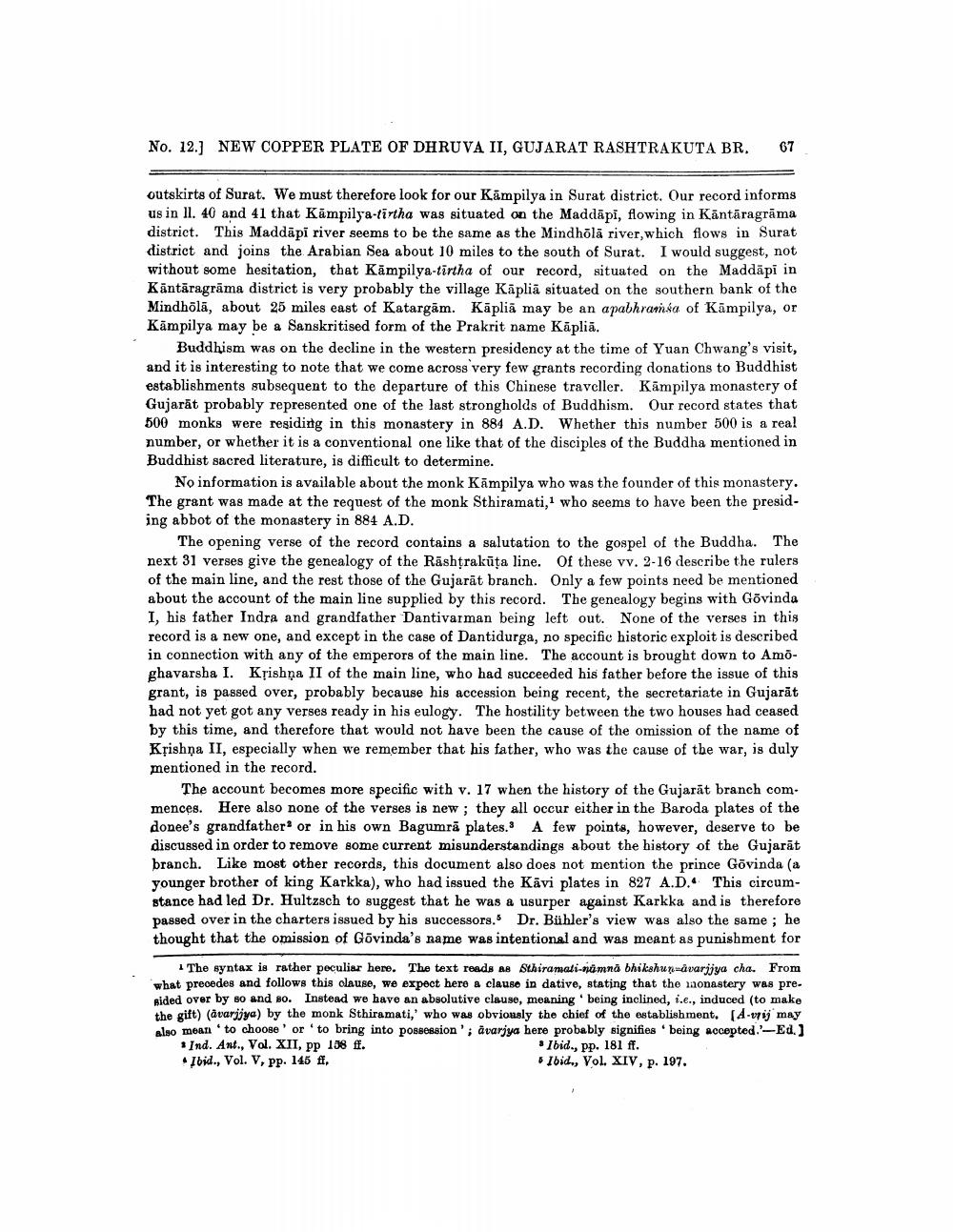________________
No. 12.] NEW COPPER PLATE OF DHRUVA II, GUJARAT RASHTRAKUTA BR. 67
outskirts of Surat. We must therefore look for our Kampilya in Surat district. Our record informs us in II. 40 and 41 that Kampilya-tirtha was situated on the Maddāpi, flowing in Kantāragrāma district. This Maddāpi river seems to be the same as the Mindhōla river, which flows in Surat district and joins the Arabian Sea about 10 miles to the south of Surat. I would suggest, not without some hesitation, that Kampilya-tirtha of our record, situated on the Maddapi in Kāntāragrāma district is very probably the village Kaplia situated on the southern bank of the Mindhōla, about 25 miles east of Katargām. Kāplia may be an apabhramsa of Kampilya, or Kampilya may be a Sanskritised form of the Prakrit name Kāplia.
Buddhism was on the decline in the western presidency at the time of Yuan Chwang's visit, and it is interesting to note that we come across very few grants recording donations to Buddhist establishments subsequent to the departure of this Chinese traveller. Kampilya monastery of Gujarat probably represented one of the last strongholds of Buddhism. Our record states that 500 monks were residing in this monastery in 884 A.D. Whether this number 500 is a real number, or whether it is a conventional one like that of the disciples of the Buddha mentioned in Buddhist sacred literature, is difficult to determine.
No information is available about the monk Kampilya who was the founder of this monastery. The grant was made at the request of the monk Sthiramati,1 who seems to have been the presiding abbot of the monastery in 884 A.D.
The opening verse of the record contains a salutation to the gospel of the Buddha. The next 31 verses give the genealogy of the Rashtrakuṭa line. Of these vv. 2-16 describe the rulers of the main line, and the rest those of the Gujarat branch. Only a few points need be mentioned about the account of the main line supplied by this record. The genealogy begins with Govinda I, his father Indra and grandfather Dantivarman being left out. None of the verses in this record is a new one, and except in the case of Dantidurga, no specific historic exploit is described in connection with any of the emperors of the main line. The account is brought down to Amōghavarsha I. Krishna II of the main line, who had succeeded his father before the issue of this grant, is passed over, probably because his accession being recent, the secretariate in Gujarāt had not yet got any verses ready in his eulogy. The hostility between the two houses had ceased by this time, and therefore that would not have been the cause of the omission of the name of Krishna II, especially when we remember that his father, who was the cause of the war, is duly mentioned in the record.
The account becomes more specific with v. 17 when the history of the Gujarat branch commences. Here also none of the verses is new; they all occur either in the Baroda plates of the donee's grandfather or in his own Bagumra plates. A few points, however, deserve to be discussed in order to remove some current misunderstandings about the history of the Gujarat branch. Like most other records, this document also does not mention the prince Govinda (a younger brother of king Karkka), who had issued the Kävi plates in 827 A.D. This circumstance had led Dr. Hultzsch to suggest that he was a usurper against Karkka and is therefore passed over in the charters issued by his successors.5 Dr. Bühler's view was also the same; he thought that the omission of Govinda's name was intentional and was meant as punishment for
The syntax is rather peculiar here. The text reads as Sthiramali-namna bhikshun-avarjjya cha. From what precedes and follows this clause, we expect here a clause in dative, stating that the monastery was preBided over by so and so. Instead we have an absolutive clause, meaning being inclined, i.e., induced (to make the gift) (avarjjya) by the monk Sthiramati,' who was obviously the chief of the establishment. [A-vrij may also mean to choose' or 'to bring into possession'; avarjya here probably signifies being accepted.'-Ed.] Ind. Ant., Vol. XII, pp 108 ff. Ibid., pp. 181 ff. Ibid., Vol. V, pp. 145 ff,
4
Ibid., Vol. XIV, p. 197.




